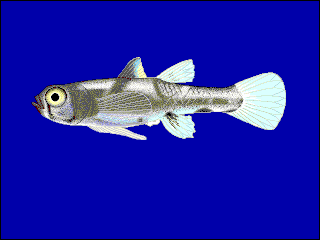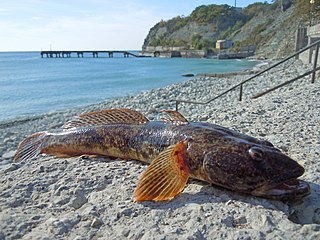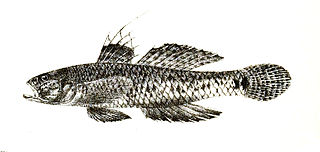
Nemateleotris magnifica, known by a variety of common names including fire goby, magnificent fire fish, fire dartfish, or red fire goby, is a species of dartfish native to coral reefs of the Indian and Pacific oceans.

The dwarf pygmy goby or Philippine goby is a tropical species of fish in the subfamily Gobionellinae from brackish water and mangrove areas in Southeast Asia. It is one of the smallest fish species in the world. Males reach maturity at a standard length of 0.9 cm (0.35 in) and can reach up to 1.1 cm (0.43 in) in standard length, while the females can grow up to 1.5 centimetres (0.59 in) in total length. Adults weigh around 4 milligrams (0.00015 oz). It is known as bia and tabios in the Philippines.

Acentrogobius is a genus of gobies native to marine, fresh and brackish waters of the coasts of the Indian Ocean and the western Pacific Ocean.
Chlamydogobius squamigenus, the Edgbaston goby, is a critically endangered species of goby endemic to the Edgbaston Reserve in Central Queensland, Australia where it occurs in small pools with clay bottoms and emergent tussock grasses. This species can reach a length of 4.8 centimetres (1.9 in) SL. The red-finned blue-eye, 11 snail species, a small crustacean, a flatworm, a spider and a dragonfly are restricted to the same springs and also threatened.
Lentipes whittenorum is a species of goby endemic to marine, brackish and fresh waters of Indonesia. The specific name jointly honours the biologists Anthony (Tony) and Jane Whitten, who assisted the describer Kottelat in a number projects in Indonesia, particularly in the survey of Bali, an island on which this goby occurs.

Mesogobius batrachocephalus, the knout goby or toad goby, is one of the species of gobiid fish native to the Black Sea and the Sea of Azov basins. It lives in estuaries and brackish water lagoons, occasionally in fresh waters, such as the coastal Lake Siutghiol in Romania. It prefers areas near cliffs with sandy, shelly or rocky substrates at depths of from 20 to 60 metres, sometimes down to 100 metres (330 ft). The knout goby is a piscivore. It can reach a length of 34.5 centimetres (13.6 in) SL and weight of 600 grams (1.3 lb). Maximum known age is eight years.

Favonigobius reichei, the Indopacific Tropical Sand Goby, is a species of goby native to fresh, brackish and marine waters of coastal areas of the Indian Ocean and the western Pacific Ocean preferring muddy or sandy substrates, often with weed growth. This species can reach a length of 8.3 centimetres (3.3 in) TL.

Redigobius bikolanus, the speckled goby or bigmouth goby, is a species of goby native to marine, fresh and brackish waters along the coasts of Asia from Japan to Australia out to the Pacific islands of New Caledonia and Vanuatu and along the coast of South Africa and the Seychelles. This species inhabits streams, creeks and estuaries, often being found upstream beyond the tidal zones of rivers. This fish can reach a length of 4.2 centimetres (1.7 in) SL.
Mugilogobius sarasinorum, Sarasin's goby, is a species of goby endemic to Lake Poso in Sulawesi, Indonesia. This species can reach a length of 8 centimetres (3.1 in) TL. It is important to local commercial fisheries and the fishing community.

Cavefish or cave fish is a generic term for fresh and brackish water fish adapted to life in caves and other underground habitats. Related terms are subterranean fish, troglomorphic fish, troglobitic fish, stygobitic fish, phreatic fish, and hypogean fish.

Gobiodon citrinus, the poison goby, is a species of goby native to the Indian Ocean from the Red Sea and the coast of Africa to the western Pacific Ocean to Japan, Samoa and the Great Barrier Reef. They are reef dwellers being found at depths of from 2 to 20 metres and in association with Acropora corals. The mucus produced by this fish is toxic. They grow to a length of 6.6 centimetres (2.6 in) TL. They have varied body colour and could be either dark brown, or pale yellow. They also have blue vertical lines that go around their eyes and gills. This species is also found in the aquarium trade and has been reared in the aquarium.

The yellow prawn-goby is a species of goby native to the Western Pacific, where it can be found at depths of from 1 to 25 metres in coastal bays and lagoons. This species is symbiotic with alpheid shrimps. They share burrows with these shrimp. The species can reach a length of 10 centimetres (3.9 in) SL. These fish vary greatly in appearance, ranging from brilliant yellow to gray and even brown forms or combinations of each coloring. This species is often kept in salt water aquariums. The yellow prawn-goby can be kept in aquariums as small as 20 gallons. In the marine hobby they are often partnered with tiger pistol shrimp.

Lythrypnus dalli, commonly known as the blue-banded goby or Catalina goby, is a species of goby. It is native to the eastern Pacific where it is found from Monterey Bay, California to northern Peru, including the Gulf of California. It can be found in coastal waters at depths of from 0 to 76 metres with rocky substrates in which there are crevices for concealment. It is also known to hide amongst the spines of sea urchins. It is a bidirectional hermaphrodite and capable of rapidly switching sexes. This species can reach a length of 6.4 centimetres (2.5 in) TL. It can also be found in the aquarium trade. The specific name honours the malacologist William Healey Dall (1845-1927), who when trawling for specimens off Catalina Harbour, California, caught one of the type specimens.

Amblyeleotris wheeleri, the Gorgeous prawn-goby, is a species of goby native to tropical reefs of the Indian Ocean to the western Pacific Ocean. It can be found at depths of from 5 to 40 metres though is usually does not occur deeper than 15 metres (49 ft). It is a commensal with alpheid shrimps, most often being found in association with Alpheus ochrostriatus. This species can reach a length of 10 centimetres (3.9 in) SL. It can also be found in the aquarium trade.

Oxyurichthys microlepis, commonly known as the maned goby, is a species of goby native to tropical marine and brackish waters along the coasts of the Indian Ocean from Africa to the western Pacific Ocean where it occurs in estuaries and inshore waters to depths of about 75 metres (246 ft). It occurs in the Mekong Delta and is suspected to use the tidal flow up the river to reach as far inland as Cambodia. This species can reach a length of 13.5 centimetres (5.3 in) TL. It is of minor importance to local commercial fisheries and can also be found in the aquarium trade.

True gobies were a subfamily, the Gobiinae, of the goby family Gobiidae, although the 5th edition of the Fishes of the World does not subdivide the Gobiidae into subfamilies. They are found in all oceans and a few rivers and lakes, but most live in warm waters. Altogether, the Gobiinae unite about 1149 described species in 160 genera, and new ones are still being discovered in numbers.

Oplopomus is a genus of gobies found in coral reefs of the Indo-Pacific region. It contains two species.

Pseudogobius is a genus of fish in the goby family, Gobiidae. It is widely distributed in tropical and temperate regions of the Indian and western Pacific Oceans. Species occur in freshwater and estuarine habitat types, such as mangroves and seagrass beds.

Acentrogobius cyanomos, or the threadfin blue goby is an amphidromous benthopelagic species of goby found in brackish and salt water in Bangladesh, India, Indonesia, Malaysia, and Thailand. Individuals grow up to 11.5 centimetres (4.5 in) long.

Acentrogobius dayi, also known as Day's goby, is a species of goby found in the western Indian Ocean from the Persian Gulf to Pakistan. It is also found in brackish and freshwater streams of south-western Asia.


















